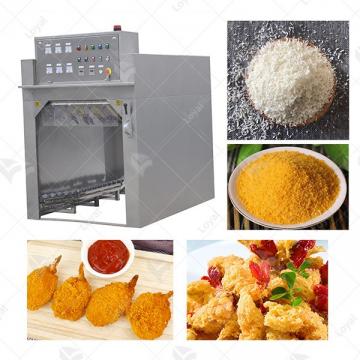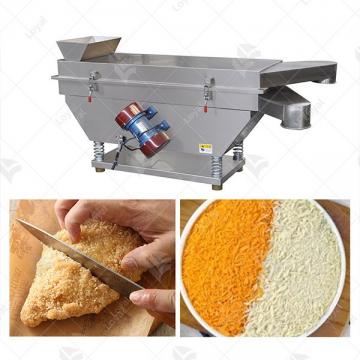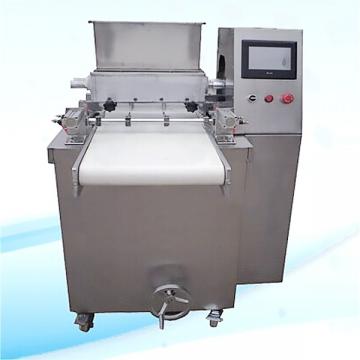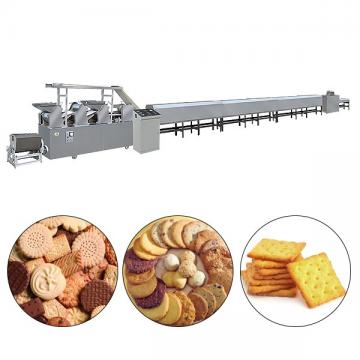
- Shandong Loyal Industrial Co.,Ltd.
- Macaroni Production Machine Instant Noodle Machine Biscuit Making Machine
Home> Processing> Unlock The Secrets Of Efficient biscuit production line Manufacturing

Unlock The Secrets Of Efficient biscuit production line Manufacturing
2025-06-25 10:05:49If you want to know more story about LOYAL brand, here can help you - https://www.facebook.com/foodmachineloyal
Overview of hard and soft biscuit
Biscuit, as globally popular convenient foods, are mainly divided into two major categories based on their formulas, production processes, and texture characteristics: hard biscuits and soft biscuit. These two types differ significantly in terms of ingredients, processes, and taste.
1.Soft biscuit: Made primarily from low-gluten flour, they contain a high amount of fat and sugar (fat typically accounts for 25%-50% of the flour, and sugar for 32%-50%). The dough has little gluten formation, lacks elasticity and extensibility, but has good plasticity and stickiness. The finished product is crumbly and melts in the mouth, with a cross-section that shows a porous, non-layered texture. Typical products include butter cookies, biscuits, and various decorative embossed biscuits. Due to their rich milk flavor and delicate texture, they are often enjoyed as snacks or with tea.
2.Hard biscuit:The ingredients contain low levels of fat and sugar (fat usage typically does not exceed 20% of the flour). The dough requires extensive mixing to form a well-developed gluten network, resulting in strong extensibility and elasticity. The final product has a crisp and chewy texture with a distinct layered structure. Common products include animal biscuits, soda biscuits, and breakfast biscuits. Due to their relatively low fat content and firmer structure, they are suitable for portable snacks or as breakfast supplements.
|
Hard biscuit |
The dough for this cookie is elastic and stretchy, requires long multi-stage rolling with resting between stages. |
|
Soft biscuit |
Soft biscuits are made from crumbly and fragile short bread dough. |
|
Features |
Soft biscuit |
Hard biscuit |
|
Ingredient formula |
High-fat, high-sugar, low-gluten flour |
Low fat, low sugar, medium/high gluten flour |
|
Degree of gluten formation |
Stir for 2-5 minutes. |
Thoroughly mix (requires long stirring) |
|
Forming method |
Single-roll forming |
Multi-pass rolling + lamination composite |
|
products |
Cookies, cream biscuits, peach pastry |
Soda crackers, animal crackers, breakfast biscuits |
|
taste |
Fluffy and delicate, it melts in your mouth |
Crisp, hard, and resilient with a strong layered texture. |
In modern food industry, the production of two types of biscuits has developed into highly specialized automated production lines. These lines achieve efficient and standardized production through precise raw material handling, forming techniques, baking control, and post-processing procedures. The production lines not only meet basic production needs but also adapt to various product changes through modular design, demonstrating technological integration and innovation in the field of food processing.

Detailed explanation of the biscuit production line process
Process flow of soft biscuit production line
The process of a soft biscuit production line is relatively simple, focusing on maintaining the loose structure of the dough while avoiding excessive mechanical processing that could lead to gluten formation. The core process includes six steps:
1.Pre-treatment of raw materials and dough preparation: Low-gluten flour is sifted and mixed with powdered ingredients such as milk powder, baking soda, and ammonium bicarbonate in a plastic tray. Liquid ingredients like vegetable oil, lecithin, sucrose, salt, and flavoring are mixed in a beaker. The liquid mixture is then poured into a mixer, followed by a small amount of water used to rinse the beaker, which is also added. The mixer is turned on for rapid stirring for about 2 minutes. Then, the dry ingredient mixture is added, and rapid stirring continues for another 4 minutes, forming a dough with low gluten content and moderate viscosity (total mixing time controlled within 6 minutes).
2.Rolling and shaping: After removing the dough from the mixer, place it on a baking tray and initially roll it into a thin sheet using a rolling pin. Fold it into four layers and roll again. Repeat this process 2-3 times to form a uniform sheet that is 2-3mm thick. Use a roller imprint molding machine to press the cookie dough at once, with molds that can be changed according to product requirements to various patterns and shapes. The trimmings produced during this process can be promptly recycled and reused, avoiding repeated processing of the dough.
3.Baking: Shape the cookie dough and place it into a tunnel oven. Bake at 240°C for 4-5 minutes. During baking, closely monitor the browning process because the cookies will continue to darken after they come out of the oven. Therefore, they should appear slightly lighter than the desired color when removed. The hot air circulation system ensures even temperature distribution, allowing the cookies to rise properly and develop a golden color.
4.Oiling: After baking, cookies are immediately passed through an oil sprayer, where they are evenly coated with palm oil, rapeseed oil, or flavor oils (typically 5%-10% of the cookie's weight), enhancing their taste, aroma, and appearance gloss. The oiling system can be equipped with atomization control to ensure uniform oil coating.
5.Cooling: After spraying oil, the cookies enter the cooling system (usually a multi-layer mesh conveyor) and cool naturally in an environment around 40°C, reducing moisture to below 3% and lowering the core temperature of the cookies to about 30°C. The cooling process lasts approximately 10-15 minutes and is crucial for the final crispness and structural stability of the cookies.
6.After cooling, the completed cookies are organized and arranged by the cookie machine manager, then automatically packaged by an automatic packaging machine using OPP/CPP composite bags or aluminum foil bags. The finished product is stored in an environment with temperatures below 25°C and relative humidity below 60%, maintaining its crisp texture.

Hard biscuit production line process
The process of a hard biscuit production line is more complex, emphasizing the stretching and layering of the dough. Key steps include:
1.Preparation and mixing of ingredients: Use medium to high gluten flour, combined with an appropriate amount of sugar, fat (animal fat or vegetable oil), and water. After accurately weighing the ingredients, they are added to a mixer for long-term low to moderate speed mixing (15-30 minutes) to promote the full formation of gluten, resulting in a dough that is both elastic and extensible.
2.Compound rolling and layering: The dough is rolled through three consecutive rollers to form an even thin sheet. It then goes into a laminator to fold into multiple layers (usually 3-7 layers), which is crucial for creating the distinctive layers of crumbly cookies. After layering, optional fillings such as jam or cream can be added to produce layered or two-tone cookies.
3.Shaping: The layered dough sheets are cut into shape using a rotary cutter or a continuous calendering machine. Resilient cookies are typically thinner, with the shaping machine equipped with three or four dough rollers and one mold roller to ensure precise thickness control (0.5-2mm). The trimmings are returned to the feeder hopper for recycling by a side scrap recovery system.
4.Sprinkle and bake: Shaped dough can be decorated with salt, sugar granules, or sesame seeds using a belt-type sprinkler. A salt and sugar recovery device is equipped before entering the oven to reduce waste. Baking is done using a segmented temperature-controlled tunnel oven (210-250℃) for about 6-7 minutes, with a stable heat source provided by vertical or horizontal combustion systems (gas/oil/electric).
5.Sugar spraying/oil spraying and secondary drying: After baking, cookies can optionally have sugar solution applied by a sugar sprayer or oil sprayed by an oil sprayer. The products then enter a secondary drying oven (100-120°C) for 1-2 minutes to solidify the surface coating. When this function is not used, the equipment can switch to a cooling channel.
6.Cooling and organizing: After being sprayed with oil, the biscuits enter a cooling line to fully cool down. They then pass through a differential speed biscuit aligner, which arranges the flat biscuits into an upright and orderly pattern. This makes it easier for manual inspection and removal of defective products, while also improving the efficiency of subsequent packaging.

What are the advantages of this line?
1.A complete soft and hard biscuit production line , which can make all kinds of biscuits of various shapes, just change the mold.
●Soft & Hard Biscuits: Adjust dough consistency, baking time, and temperature to produce chewy, crispy, or layered biscuits.
●Multiple Shapes & Designs: Simply change the mold to switch between round, square, animal-shaped, or custom-designed biscuits.
●Wide Recipe Compatibility: Works with various dough types, including sugar-based, savory, gluten-free, and high-fiber recipes.
2.The biscuit production line can be customized according to the customer's workshop or biscuit making technical requirement
●Adaptable Layout: The machine can be adjusted in size, conveyor length, and configuration to fit small, medium, or large workshops.
●Tailored Technical Specifications: Customize baking time, temperature zones, and cooling speed based on your biscuit type.
●Optional Add-ons: Additional modules like chocolate coating, cream filling, or double-layer baking can be integrated.
3.Have different heating sources for your operation (Electric, gas, Diesel oil)
●Electric Heating: Best for stable temperature control, suitable for indoor factories with electricity supply.
●Gas Heating: Cost-effective for large-scale production with consistent heat distribution.
●Diesel Oil Heating: Ideal for areas with limited gas or electricity access, providing high thermal efficiency.
4.It is full automatic, advanced technology, easy to operation, high quality,save energy & labor, reasonable price to win customer reply and reputation.
●PLC Touch Screen Control: Easy-to-use interface for adjusting speed, temperature, and baking time.
●Energy-Saving Design: Optimized heat circulation and insulation reduce power consumption.
●Minimal Labor Requirement: Automated feeding, forming, baking, and packaging reduce manual work.
●Smooth & Stable Performance: Precision-engineered components ensure low maintenance and long service life
●In today's increasingly competitive biscuit industry, (company name) focuses on real challenges in production and helps customers :
Reduce energy costs
Improve yield
Gain small-lot flexible production capacity
The automatic biscuit production line is composed of a sophisticated biscuit forming machine, an electric baking oven with precise temperature control, an oil spraying machine that ensures even coating, a turning machine for uniform baking, a cooling line that rapidly cools the freshly baked biscuits, a biscuit finishing machine that polishes and shapes the final product, and a packing table for neat and secure packaging. The whole line is seamlessly controlled by a state-of-the-art CPU module, featuring back-hung motor drives that provide smooth and efficient operation. Its compact structure maximizes space utilization while maintaining a high degree of automation. This advanced machinery can produce a variety of high-quality cookies, including delectable cream-filled and jam-filled options, each with a perfect balance of texture and flavor.

Reference
The following are five authoritative foreign literature websites in the field of Industrial food machinery:
1. Food Engineering Magazine
Website: https://www.foodengineeringmag.com/
2.Food Processing Magazine
Website: https://www.foodprocessing.com/
3.Journal of Food Engineering
Website:https://www.journals.elsevier.com/journal-of-food-engineering
4. Food Manufacturing Magazine
Website:https://www.foodmanufacturing.com/
5. International Journal of Food Science & Technology
Website:https://onlinelibrary.wiley.com/
 Commercial Japanese Panko Bread Crumb Grinder Machine
Commercial Japanese Panko Bread Crumb Grinder Machine Japanese Bread Crumbs Processing Line
Japanese Bread Crumbs Processing Line Automatic Cookies Making Machines
Automatic Cookies Making Machines Fully Automatic Biscuit Making Machines
Fully Automatic Biscuit Making Machines